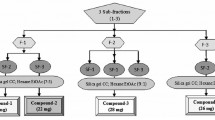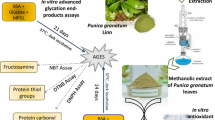Abstract
Free radical scavenging and advanced glycation end-product (AGE) inhibitory potential were evaluated in the crude methanol extract of Dichrostachys cinerea. Bioassay-guided isolation led to the identification of four flavan-3-ols, namely (−)-mesquitol (1), oritin (2), (−)-festidinol (3) and (−)-epicatechin (4). Analysis of structure–activity relationships revealed that the presence of 7,8-dihydroxyl groups in the A-ring of flavan-3-ols in conjunction with 3′,4′-dihydroxyls in the B-ring (1) is an important criterion for displaying potent AGE inhibitory activity along with free radical scavenging properties. (−)-Mesquitol (1), oritin (2), and (−)-festidinol (3) were found to be new natural AGE inhibitors. (−)-Mesquitol (1) displayed the most potent AGE inhibitory activity. Results suggest that (−)-mesquitol (1) may serve as an important natural organic lead compound for future development of antiglycating agents along with potent antioxidant activity.



Similar content being viewed by others
References
Striban A, Tschoepe D, Stratmann B (2009) Shifting the disease management paradigm from glucose: what are the pros? Diabetes Care 32:S349–S352
Meerwaldt R, Links L, Zeebregts C, Tio R, Hillebrands J, Smit A (2008) The clinical relevance of assessing advanced glycation endproducts accumulation in diabetes. Cardiovasc Diabetol 7:29
Beisswenger PJ, Howell SK, O’Dell RM, Wood ME, Touchette AD, Szwergold BS (2001) α-Dicarbonyls increase in the postprandial period and reflect the degree of hyperglycemia. Diabetes Care 24:726–732
Stirban A, Negrean M, Starmann B, Gawlowski T, Horstmann T, Gotting C, Kleesiek K, Muller-Roesel M, Koschinsky T, Uribarri J, Vlssara H, Tschoepe D (2006) Benfotiamine prevents macro- and microvascular endothelial dysfunction and oxidative stress following a meal rich in advanced glycation end products in individuals with type 2. Diabetes Care 29:2064–2071
Tiwari AK, Rao JM (2002) Diabetes mellitus and multiple therapeutic approaches of phytochemicals: present status and future prospects. Curr Sci 83:30–38
Tiwari AK (2004) Antioxidants: new generation therapeutic base for treatment of polygenic disorders. Curr Sci 86:1092–1102
Yamasaki K, Hishiki R, Kato E, Kawabata J (2011) Study of kaempferol glycoside as an insulin mimic reveals glycon to be the key active structure. ACS Med Chem Lett 2:17–21
Sharma PV (2006) The classical uses of medicinal plants, (Haridas Ayurveda Series-4, Chankhambha Visvabharathi, Varnasi, India), 1st edn, pp 348–349
Rao RJ, Tiwari AK, Kumar US, Reddy SV, Ali AZ, Rao JM (2003) Novel 3-O-acyl mesquitol analogues as free-Radical scavengers and enzyme inhibitors: synthesis, biological evaluation and structure–activity relationship. Bioorg Med Chem Lett 13:2777–2780
Bennie L, Coetzee J, Malan E, Ferriera D (2002) (4→6)-Coupled proteracacinidins and promelacacinidins from Acacia galpinii and Acacia caffra. Phytochemistry 60:521–532
Foo LY, Hritch L, Vilain C (1985) Phylloflavan, a characteristic constituent of Phyllocladus species. Phytochemistry 24:1495–1498
Morimoto S, Nonaka GI, Nishioka I, Ezaki N, Takizawa N (1985) Tannins and related compounds. XXIX. Seven new methyl derivatives of flavan-3-ols and a 1,3-diarylpropan-2-ol from Cinnamomum cassia, C. obtusifolium and Lindera umbellata var. membranacea. Chem Pharm Bull 33:2281–2286
Matsuda H, Wang T, Managi H, Yoshikawa M (2003) Structural requirements of flavonoids for inhibition of protein glycation and radical scavenging activities. Bioorg Med Chem 11:5317–5323
Sultana N, Choudhary MI, Khan A (2009) Protein glycation inhibitory activities of Lawsonia inermis and its active principles. J Enzyme Inhib Med Chem 24:257–261
Tiwari AK, Swapna M, Ayesha SB, Zehra A, Agawane SB, Madhusudana K (2011) Identification of proglyceamic and antihyperglyceamic activity in antioxidant rich fraction of some common food grains. Int Food Res J 18:883–891
Acknowledgments
Authors thank Dr. J. S. Yadav, Director, Indian Institute of Chemical Technology for his constant encouragement. This work was financially supported by the grant NWP-0004 from Council of Scientific and Industrial research, New Delhi (India) under CSIR-Network program.
Author information
Authors and Affiliations
Corresponding authors
Rights and permissions
About this article
Cite this article
Suresh, G., Tiwari, A.K., Radha Krishna Murthy, M. et al. New advanced glycation end-products inhibitors from Dichrostachys cinerea Wight & Arn.. J Nat Med 66, 213–216 (2012). https://doi.org/10.1007/s11418-011-0557-3
Received:
Accepted:
Published:
Issue Date:
DOI: https://doi.org/10.1007/s11418-011-0557-3




